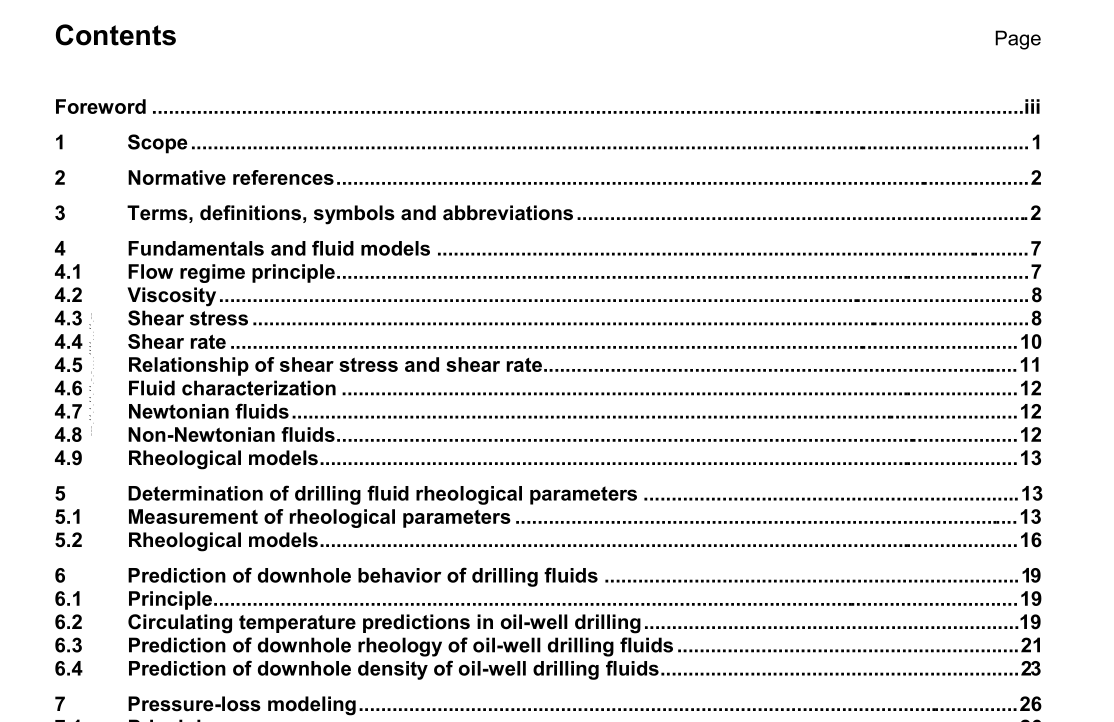API RP 13D pdf download

API RP 13D pdf download.API Recommended Practice 13D — Rheology and hydraulics of oil- well drilling fluids
1 Scope
1.1 The objective of this Recommended Practice (RP) is to provide a basic understanding of and guidance about drilling fluid rheology and hydraulics, and their application to drilling operations. 1.2 The target audience for this RP covers both the office and wellsite engineer. The complexity of the equations used is such that a competent engineer can use a simple spreadsheet program to conduct the analyses. Given that the equations used herein are constrained by the spreadsheet limitation, more advanced numerical solutions containing multiple subroutines and macros are not offered. This limitation does not mean that only the results given by the spreadsheet methods are valid engineering solutions. 1.3 Rheology is the study of the deformation and flow of matter. Drilling fluid hydraulics pertains to both laminar and turbulent flow regimes. The methods for the calculations used herein take into account the effects of temperature and pressure on the rheology and density of the drilling fluid. 1.4 For this RP, rheology is the study of flow characteristics of a drilling fluid and how these characteristics affect movement of the fluid. Specific measurements are made on a fluid to determine rheological parameters under a variety of conditions. From this information the circulating system can be designed or evaluated regarding how it will accomplish certain desired objectives. 1.5 The purpose for updating the existing Recommended Practice, last published in May 2003, is to make the work more applicable to the complex wells that are now commonly drilled. These include: High-Temperature/High-Pressure (HTHP), Extended-Reach Drilling (ERD), and High-Angle Wells (HAW). Drilling fluid rheology is important in the following determinations:a) calculating frictional pressure losses in pipes and annuli b) determining equivalent circulating density of the drilling fluid under downhole conditions c) determining flow regimes in the annulus d) estimating hole-cleaning efficiency e) estimating swab/surge pressures f) optimizing the drilling fluid circulating system for improved drilling efficiency 1.6 The discussion of rheology in this RP is limited to single-phase liquid flow. Some commonly used concepts pertinent to rheology and flow are presented. Mathematical models relating shear stress to shear rate and formulas for estimating pressure losses, equivalent circulating densities and hole cleaning are included. 1.7 The conventional U.S. Customary (USC) unit system is used in this Recommended Practice. 1.8 Conversion factors and examples are included for all calculations so that USC units can be readily converted to SI units.Where units are not specified, as in the development of equations, any consistent system of units may be used. 1.9 The concepts of viscosity, shear stress, and shear rate are very important in understanding the flow characteristics of a fluid. The measurement of these properties allows a mathematical description of circulating fluid flow. The rheological properties of a drilling fluid directly affect its flow characteristics and all hydraulic calculations. They must be controlled for the fluid to perform its various functions. 1.10 This revised document includes some example calculations to illustrate how the equations contained within the document can be used to model a hypothetical well. Due to space constraints, it has not been possible to include a step- by-step procedure for every case. However, the final results should serve as a benchmark if the user wishes to replicate the given cases.
4 Fundamentals and fluid models
4.1 Flow regime principle 4.1.1 The behavior of a fluid is determined by the flow regime, which in turn has a direct effect on the ability of that fluid to perform its basic functions. The flow can be either laminar or turbulent, depending on the fluid velocity, size and shape of the flow channel, fluid density, and viscosity. Between laminar and turbulent flow, the fluid will pass through a transition region where the movement of the fluid has both laminar and turbulent characteristics. It is important to know which of the flow regimes is present in a particular situation to evaluate the performance of a fluid. If the flow occurs in an annulus, like in a drilling situation, the rotation of the inner surface (the drillpipe) can create turbulent instabilities for all flow rates. 4.1.2 In axial laminar flow, the fluid moves parallel to the walls of the flow channel in smooth lines. Flow tends to be laminar when moving slowly or when the fluid is viscous. In laminar flow, the pressure required to move the fluid increases with increases in the velocity and viscosity. 4.1.3 In turbulent flow, the fluid is swirling and eddying as it moves along the flow channel, even though the bulk of the fluid moves forward. These velocity fluctuations arise spontaneously. Wall roughness or changes in flow direction will increase the amount of turbulence. Flow tends to be turbulent with higher velocities or when the fluid has low viscosity. In turbulent flow, the pressure required to move the fluid increases linearly with density and approximately with the square of the velocity. This means more pump pressure is required to move a fluid in turbulent flow than in laminar flow.









